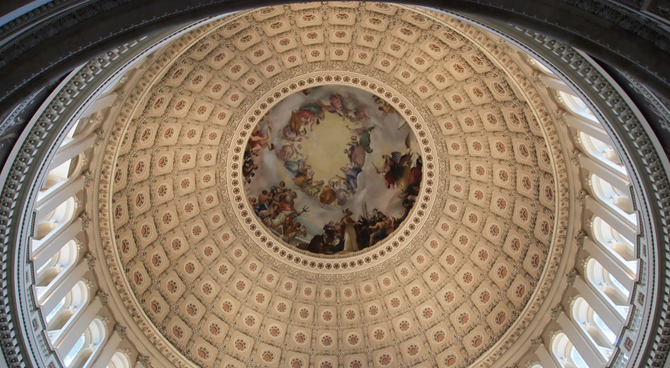Senate Finance Chairman Ron Wyden now recognizes that a pro-growth tax reform can raise revenues.
By Phil Gramm and Mike Solon
A glimmer of hope for the economy and deficit reduction flashed from the Senate this past weekend when the new Senate Finance Committee Chairman, Ron Wyden, announced “a breakthrough” on tax reform. When asked by Bloomberg’s Al Hunt if tax reform should raise revenues, Mr. Wyden replied that the Congressional Budget Office had committed to him to “actually score pro-growth tax reform as generating revenue.”
This is a breakthrough. Until now, the refusal of Senate Democrats to recognize a revenue dividend coming from a pro-growth tax code has been the biggest stumbling block to comprehensive reform.
Two major hurdles remain: the president’s position that he would rather lose federal revenues and economic growth than “unfairly” lower tax rates, and Democrats’ misplaced perception of the importance of the inequality debate to their efforts to hold the Senate. Even so, Mr. Wyden could become the first Democratic champion of pro-growth tax reform since Dick Gephardt and Bill Bradley helped push through the successful tax reform in 1986.
Recognizing that government can be a beneficiary from pro-growth tax reform makes it possible for Mr. Obama to get more revenues without Republicans having to vote for a tax hike. This is the glue that makes a bipartisan deal possible.
The real driver behind this breakthrough is a series of recent CBO reports showing how slower growth is bleeding the federal government of trillions in revenues. Since the recession began in 2007, CBO’s 10-year projections show that $4.9 trillion in revenues have been lost solely due to slower growth. And while the recession was the initial cause, a CBO report released this month says that about half the losses are due to the weak recovery, with $2.3 trillion in projected revenue losses occurring after the White House’s announced “summer of recovery” began in 2010.
Those losses are accelerating, with $1.4 trillion of lost revenues reported in the most recent CBO downgrade of economic growth. The decline in expected future growth over the next decade is projected to cost the U.S. Treasury more than twice the $617 billion tax increase it hoped to receive from the January 2013 repeal of provisions of the Bush tax cuts.
In 2009, when the president and his Democratic Congress put in place their economic recovery program, they projected strong growth to result, with the OMB and CBO estimating 4.2% real average GDP growth for 2011-13. These projections were not hard to believe given the pattern of past recoveries, such as the 5.4% average GDP growth in the three years after the previous deepest postwar recession in 1982. The problem was the Obama program did not promote growth, it impeded it.
Real GDP growth averaged just 2.2% during the 2011-13 period, less than half the norm for postwar recoveries. Even worse, the CBO now says our long-term growth prospects have been permanently lowered after the weakest recovery in 75 years. CBO’s 2009 projection of a potential GDP growth rate of 2.4% (for the next decade) has now been reduced to just 2.2% due to lower national productivity, lower capital investment, and fewer work hours resulting from the recession, the weak recovery and the effects of ObamaCare.
The only practical way to recapture these revenues is through a faster-growing economy. Mr. Wyden’s recognition that tax reform can raise revenue by boosting economic growth provides the best chance this country currently has of returning to more normal rates of economic growth.
The CBO and congressional Joint Committee on Taxation have analyzed the impact of a pro-growth tax reform. In a 2011 macroeconomic analysis of comprehensive tax reform, the Joint Committee projected the impact from lowering tax rates to range from 0% to 0.3% higher GDP in the first five years and 0.6% to 1.1% higher GDP growth in the second five years after the reductions went into effect. Applying those estimates to the most recent CBO baseline revenue projections suggests a 10-year revenue dividend in the range of $200 billion to $400 billion.
While any pro-growth revenue projection by CBO should be welcomed, the revenue dividend it projects will almost certainly be grossly underestimated. Predicting what sort of dividend might actually occur from a return to normal postwar GDP growth is difficult, but two facts suggest its potential. According to CBO, the accumulated revisions in their semiannual reports caused by slow economic growth have cost as much as $433 billion in lost revenues in a single year (2013), while higher growth produced an extra $227 billion in revenues in a single year (2001). After the 1991 and 2001 recessions, revenues lost in those recessions were in fact recaptured in the following recovery.
A pro-growth tax reform will not undo this administration’s doubling of the federal debt held by the public, its tax increases, increased regulatory burden or antibusiness bias. But it would be a major movement in the right direction. Tax reform that fueled economic growth and federal revenue growth could be a catalyst for other reforms that could bring back the American economy we once knew and took for granted.
Mr. Gramm, a former chairman of the Senate Banking Committee, is senior partner of US Policy Metrics and a visiting scholar at the American Enterprise Institute. Mr. Solon was a policy adviser to Senate Republican Leader Mitch McConnell and is a partner at US Policy Metrics.





